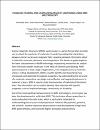HANDS-ON TRAINING AND CHARACTERIZATION OF COMPOUNDS USING NMR SPECTROSCOPY

View/
Date
2025Author
Kuna, MennatallaMohammed, Aman
Mansour, Ameen
Smati, Zainab
Haque, Anzarul
Al-Qahtani, Noora
...show more authors ...show less authors
Metadata
Show full item recordAbstract
Nuclear Magnetic Resonance (NMR) spectroscopy is a powerful tool that scientists use to unlock the mysteries of molecules. It works by probing the interactions between atomic nuclei and a magnetic field, revealing detailed information about a molecule's structure, dynamics, and composition. This hands-on guide explores the latest advancements in NMR technology, empowering researchers to analyze even the most complex molecules in the fields of chemistry and biology. NMR spectroscopy has a wide range of applications, from drug discovery to materials science. In drug development, NMR is used to identify and characterize new compounds with potential therapeutic properties. By understanding the structure of a molecule, researchers can design more effective and targeted treatments. In materials science, NMR is used to study the properties of materials at the atomic level. This information can be used to develop new materials with specific properties, such as improved strength, conductivity, or durability.
One of the most significant advancements in NMR technology in recent years has been the development of solid-state NMR. This technique allows researchers to study molecules in the solid state, which is particularly important for understanding the structure and properties of materials like polymers, proteins, and minerals. Another important advancement is the development of high-field NMR spectrometers, which provide higher resolution and sensitivity, allowing researchers to study more complex molecules and obtain more detailed information.
In addition to its applications in research, NMR spectroscopy is also used in a variety of industrial settings. For example, NMR is used to analyze food and beverages to ensure quality and safety. It is also used to monitor chemical processes and to detect contaminants in the environment. In conclusion, NMR spectroscopy is a versatile and powerful tool that has revolutionized the study of molecules. By providing detailed information about molecular structure, dynamics, and composition, NMR has enabled scientists to make significant advances in a wide range of fields. As NMR technology continues to evolve, we can expect even more exciting discoveries and applications in the future.
DOI/handle
http://hdl.handle.net/10576/62654Collections
- Center for Advanced Materials Research [1650 items ]
- Central Laboratories Unit Research [127 items ]
- The Scientific Research Theme [80 items ]

